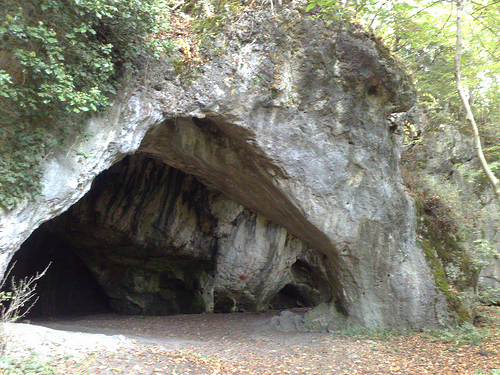

Location: Sonnenbühl, Swabian Alps Map
Overall length: 292 meters
Temperature: 8- 10 C
Bear Cave (Bärenhöhle) is located near Sonnenbühl, Swabian Alps in Germany. The
total length of Bear Cave is 292 meters and most of it is accessible
to the public. It gets its name from the remains of a cave bear
those remains were found inside. The skeleton still remains inside
connected by wires into life like stance. Besides cave bears
archaeologists discovered remains of the cave lions, rhinos and
other animals that stumbled here or were brought as a prey by the
carnivore animals.
Bear Cave was rediscovered by a teacher
Fauth in 1834 who walked in this area in search of medicinal herbs
or so the story tells. His snuff box fell into a crevice that was
later turned out to be a huge cave. Another re- discovery occurred
in 1949 by Charles Bez who tracked several bats that flew inside the
ground thus identifying the entrance site to underground cave
system. Thus another name for the Bear Cave is a Charles Cave as it
is sometimes called. However this is not the first time humans used
this cave. In the medieval times bodies of the plague victims were
thrown into the same crevice. Many of the unfortunate victims were
re- buried, but few skeletons remained inside the Bear Cave to this
day. They are visible underneath the glass.
The temperature
inside Bear Cave is fairly cool and usually ranges between 8 and 10
C throughout the year. So take some warm clothes not to freeze
yourself. You can take photos inside the cave, but avoid using
flashes. Bear Cave had problems with the growing mosses and other
primitive plants inside the cave. This is why the lights were
switched to offer less light to growing photosynthesizing plants.
Additionally they are turned off when there is no need for them.
The cave system of the Karls and Bear
Cave was created over a period of around five million years. Already
around 20,000 years ago it was frequented by cave bears, but also by
cave lions and rhinos. Some of the bears' bones can still be viewed
today, a fully reconstructed skeleton of a cave bear is on display
inside the bear cave.
The Bear Cave is now also protected as
a geotope under the name Karls- und Bärenhöhle on the south-western
slope of the Höllberg approx. Since April 2013, the bear cave has
also been one of 26 information points of the UNESCO Geopark Swabian
Alb.
The Karlshöhle was rediscovered in
1834 by the Erpfingen teacher Fauth in search of medicinal herbs.
His snuffbox had fallen into a crack in the rock. When trying to
fish them out, Fauth discovered that there was a large cave under
the gap. In his honor, the entrance column to the cave was named as
Fauthsloch. The anecdote of the discovery is still told today at the
beginning of every tour of the cave. Apparently the crevice had
already been used in the Middle Ages to throw plague victims into
it, the skeletons of which were found during exploration below the
crevice. The large number of cave bear bones found was also
striking.
In 1949, the cave guide Karl August Bez, while
watching the flight of bats, discovered the continuation of the cave
with a small passage at the end of the Karlshöhle. In this
continuation there were again significantly more bear bones, which
is why the newly discovered section was called the bear cave.
As early as 1934, the Karlshöhle was provided with electric light to make sightseeing possible. As early as 1950, just one year after the bear cave was discovered, the entire cave system was equipped with a walkable path and an artificial tunnel made it possible to exit the bear cave. Since then, the entire cave can be visited over a length of 271 meters.
The development of greenish discolouration and
moss formation on some of the rocks in the cave was probably caused
by the use of fluorescent tubes containing UV light. For this
reason, fluorescent tubes are not used in other caves and the lights
are only switched on during guided tours. Therefore, no flashing
light may be used in stalactite caves.
In 2015, the old
lights in the Bear Cave were replaced by energy-saving LED lighting.
One hall of the Karlshöhle and one of the Bear's Caves are
illuminated in color.